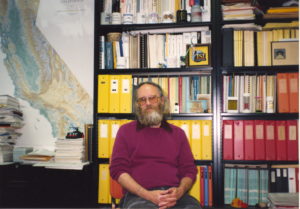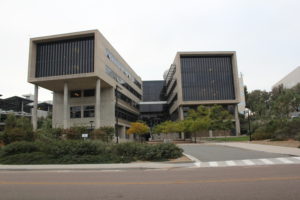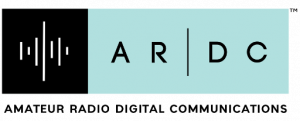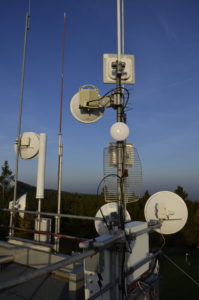One of the responsibilities of the Technical Coordinator in the Ohio Section is to submit something for the Section Journal. The Section Journal covers Amateur Radio related things happening in and around the ARRL Ohio Section. It is published by the Section Manager Scott – N8SY and articles are submitted by cabinet members.
Once my article is published in the Journal, I will also make it available on my site with a link to the published edition.
You can receive the Journal and other Ohio Section news by joining the mailing list Scott has setup. You do not need to be a member of the ARRL, Ohio Section, or even a ham to join the mailing list. Please sign up!
If you are an ARRL member and reside in the Ohio Section, update your mailing preferences to receive Ohio Section news in your inbox. Those residing outside the section will need to use the mailing list link above.
Updating your ARRL profile will deliver news from the section where you reside (if the leadership chooses to use this method).
Go to www.arrl.org and logon.
Click Edit your Profile.
You will be taken to the Edit Your Profile page. On the first tab Edit Info, verify your Email address is correct.
Click the Edit Email Subscriptions tab.
Check the News and information from your Division Director and Section Manager box.
Click Save.
Now without further ado…
Read the full edition at:
THE TECHNICAL COORDINATOR
Jeff Kopcak – TC
k8jtk@arrl.net
July 18, 2019. The date ham radio and the Internet changed forever. Most hams didn’t know it or even know that we had a block of 16.7+ million Internet IP addresses for our exclusive use. Keyword: had.
If you’re not familiar with networking and CIDR notation, CIDR (pronounced similar to the drink, cider) is a method used to note networks and ranges of IP addresses. A computer network is a connection of devices or nodes that can communicate and share resources with each other. For example: Your home PC may have the IP address: 192.168.1.100, subnet mask: 255.255.255.0. In CIDR notation, this is written as 192.168.1.100/24. Similarly, the network 192.168.1.0/24 means the same subnet mask and includes the IP above. Usable IP addresses are 192.168.1.1-192.168.1.254. “.0” is unusable as it is the network address, “.255” is not either because that is the broadcast address between all devices on that network. Since the PC has 192.168.1.100, it can communicate with devices in the 192.168.1.0/24 range. Know that smaller CIDR notations mean bigger networks (more IPs). Larger CIDR notations mean smaller networks. Networks can be broken down into smaller networks or combined to form larger ones – maybe not quickly or easily, it can be done.
In the early days of the Internet, it was believed if a node were to communicate on the Internet it had to have a public Internet address. With this thinking, very large /8 networks (16,777,216 IPs each) were assigned to companies and institutions such as: HP, Xerox, IBM, Ford, Boeing, MIT, Halliburton, Stanford, MSU, Bell Labs, DuPont, the USPS, and the DoD. They were cheap and easy to obtain! Having large networks is no longer necessary due to advances in Network Access Translations or NATs which remap one network space into another network space.

Back 40 years ago when the Internet was new and the original creators thought 4.2 trillion IP address were enough for the entire world, Hank Magnuski, KA6M and others saw the possibilities of the Internet. They obtained an Internet allocation from Dr. Jon Postel who, at that time, was responsible for overseeing allocations on the Internet. Today, allocations are the responsibility of IANA. Much like property, IP address spaces can be bought, sold, squatted, and even taken over in some cases. The non-profit organization Internet Assigned Numbers Authority (IANA) oversees Internet IP address allocations.
The allocation that was obtained is called AMPRNet (AMateur Packet Radio Network) or Network 44. In 1981, it was provided exclusively for Amateur radio operators to use packet radio, TCP/IP, and digital communications between computer networks managed by Amateur radio operators. The network consisted of addresses 44.0.0.0 through 44.255.255.255, in Internet notation 44/8 or 44.0.0.0/8, consisting of 16.7+ million IPv4 addresses.
TCP/IP was, at one time, an emerging standard and in minority use because of the protocol complexity. In typical fashion, packet node owners were outraged with this IP protocol and few systems on HF operated with this protocol because of the amount of overhead. TCP/IP then goes on to become the foundation of the Internet and in use by every device on the Internet today. Think about that anytime someone complains they don’t want to support or do something because they don’t like it.
In 1986, an agreement mandated about 8 million addresses of 44/8 be assigned for use within the United States under FCC regulations (44.0/9) and the other 8 million (44.128/9) for deployments in the rest of the world.

Since 1990, most packets destined for 44/8 were handled by a router at the University of California, San Diego. This forwarding router was originally named mirrorshades.ucsd.edu, later gw.ampr.org or “AmprGW.” This Internet “border” router (gateway) is used to route packets to and from the ordinary Internet to computers or nodes on AMPRNet. When a request hits the Internet for network 44.0.0.0/8, it is routed to UCSD. Different protocols are used to deliver the packet from the Microshades router to the destination IP address in any part of the world. Internet routers like these would be similar to an Internet Service Provider (ISP) router often handling multiple networks at once and at multiple gigabits/second transfer rate.
In 2001, UCSD used 44/8 for research as an Internet Telescope which allows observation of large-scale events taking place on the Internet using Internet Background Noise and backscatter. Backscatter is used to determine Denial of Service (DoS) attackers and victims. They were able to monitor the Code Red computer worm in 2001. All data was captured and used to generate historical trends and data. For example, when attackers on the internet start probing systems with a known set of criteria, they can go back and look when those probes first started appearing on the Internet. In 2003, 0.75 terabytes per month was recorded. In 2016, 37 terabytes per month is seen.
Since hams have had AMPRnet, many have taken advantage of it for single use applications or using small blocks on a long-term lease at zero cost. It has been used for communications ranging from simple TCP/IP connectivity, digital voice, telemetry, and repeater linking. However, not more than half of the network was ever used. Peak usage happened between 1985-1995. According to the group now overseeing 44/8, Amateur Radio Digital Communications (ARDC), a U.S. 501(c)(3) organization, less than one-third of the network is in  use today and some address blocks have never been used.
use today and some address blocks have never been used.
It wasn’t too long ago (5-10 years) that I learned about AMPRnet when I became involved in supporting an APRS Igate. I knew APRS was using the space in some aspect, the EchoLink mobile app uses the 44 network, Michigan is actively using their allocation, and Europe was using it for their HamNET Mesh. I assumed the network probably wasn’t utilized but hopeful it had enough use to keep it in the Amateur Radio community. I would have like to have liked to see ham radio Internet technologies utilize network 44 like mesh, hot spots, and newer digital voice modes (D-STAR, DMR, and Fusion). It’s a cost and complexity issue. While there is no way to put a device on the Internet with a random IP address and expect the Internet to know how to reach that device. Routes and paths need to be established as was done with the UCSD router or other routing equipment which can be very expensive to setup and

maintain. Too costly and too complex to support, other easier methods were utilized.
American Registry for Internet Numbers (ARIN), who is responsible for distribution of IP addresses on the Internet, declared on September 24, 2015 their available IPv4 pool was exhausted. The Internet was quickly running out of IP addresses! This lead the push to IPv6, which is exponentially larger. IPv4 has 4.2 trillion IP address (minus some for special uses). IPv6 has 340 undecillion, or 340 billion billion billion billion, addresses. You could assign multiple entire IPv4 sized networks per household under IPv6 and still have some left over! Exhaustion caused IPv4 allocations to become much more valuable.
Companies and institutions who still owned all or large parts of their originally assigned networks were now sitting on a gold mine. Supply and demand: a resource (IPv4 addresses) is scarce but many people want IP addresses. The price will rise, at least until IPv6 is closer to universal adoption.
This led to the ARDC decision to sell off about 4 million addresses from 44/8 on the marketplace. Total network value of 44/8 was estimated to be $100 million. From their press release:
"...in mid-2019, a block of approximately four million consecutive AMPRNet addresses denoted as 44.192.0.0/10 was withdrawn from our reserve for Amateur use, and sold to the highest qualified bidder at the then current fair market value. This leaves some twelve million addresses devoted exclusively to Amateur Radio uses, which is far greater than the number of addresses which are currently or have ever been in use. We believe this is far more than the number of addresses that will ever be needed by hams before IPv6 takes over the Internet. We also believe that was the prudent and proper time for this sale to take place, for a number of good reasons, among which are a recent levelling off in address prices and a lessening demand as only a few large buyers are left in the market for such a large block of addresses."
We now know the highest bidder was Amazon at a price of $50 million completed July 18, 2019. There is no intention by the ARDC to sell any more of the network. Post sale, AMPRNet consists of addresses 44.0.0.0 through 44.191.255.255 (44.0.0.0/9 and 44.128.0.0/10). Portion sold was the uppermost 25% of the address space, 44.192.0.0 through 44.255.255.255 or 44.192.0.0/10.
Some of the guys at work heard about this before I did because it was trending on Reddit. Initially, like most of the comments, I too was outraged. Though, figured it was coming sooner or later. An IPv4 shortage, a valuable /8 not being utilized. Wasn’t hard to put two and two together. I’m never one to say never. ‘We’re never going to use something.’ How do we know? Maybe hams develop the next Internet with that address space. Putting the politicking and whining aside, taking them at their word (continuing from the press release):
"It is our intention to grant funds across all reaches of the educational, research, and development spectrum, with awards being made to support qualified organizations whose programs could well serve to advance the art of digital communication, with special emphasis on that which would benefit Amateur Radio. Additionally, another way we will be able to help our community is to contract with research firms and consultants to carry out related research and development to produce procedures, techniques, methods, designs, and intellectual property that would then be made freely available for the benefit of all."
 While I think this is a monumental asset having this money available to promote the hobby and research, I think it puts us in a dangerous spot. To me, the similarities between this example of limited resources on the Internet and the limited resources of our radio spectrum are uncanny: ‘it’s there and not being utilized,’ ‘we’ll never use it,’ ‘resource sold for public benefit,’ ‘take the money and run,’ ‘sellouts!’ This shows that everything is up for grabs and we cannot take it for granted. Just ask France. WRC-23 is considering a proposal to make Aeronautical Mobile as the primary service in the 2-meter ham band. This is how it starts.
While I think this is a monumental asset having this money available to promote the hobby and research, I think it puts us in a dangerous spot. To me, the similarities between this example of limited resources on the Internet and the limited resources of our radio spectrum are uncanny: ‘it’s there and not being utilized,’ ‘we’ll never use it,’ ‘resource sold for public benefit,’ ‘take the money and run,’ ‘sellouts!’ This shows that everything is up for grabs and we cannot take it for granted. Just ask France. WRC-23 is considering a proposal to make Aeronautical Mobile as the primary service in the 2-meter ham band. This is how it starts.
Now more than ever, get on our resources and use them. We have more hams now than ever (in the U.S. anyway). Get on our bands. Get on our IP space. Improve the network. Grab some IPv6 space for Amateur Radio. Get involved with organizations and offer support. Yeah, everyone’s busy. If everyone’s too busy to support these organizations, we may lose all of this. Use it or lose it, so “See ya 44/8.”
Thanks for reading and 73… de Jeff – K8JTK
